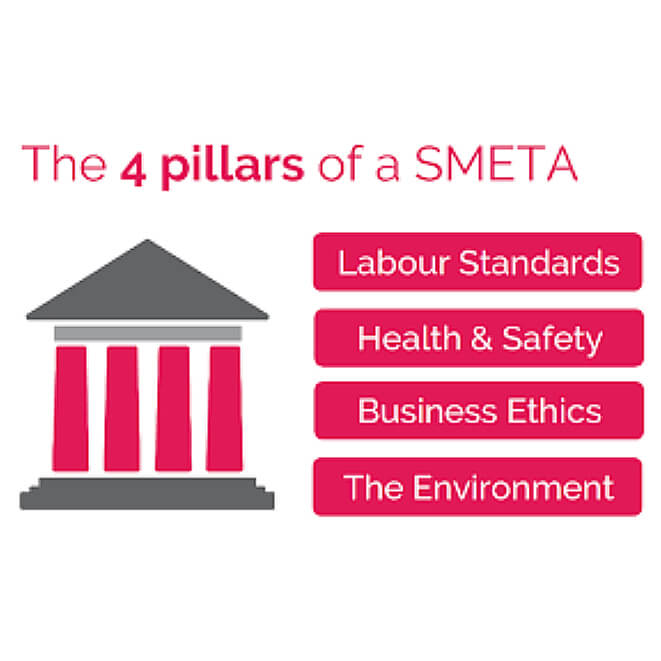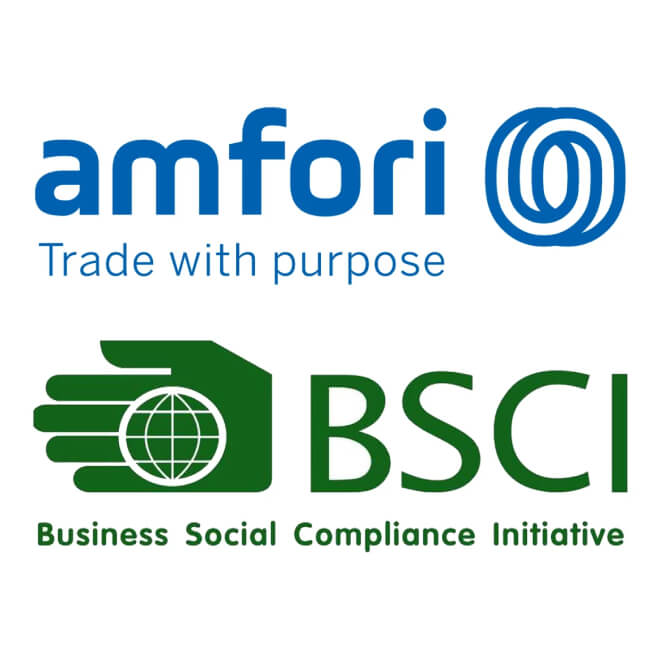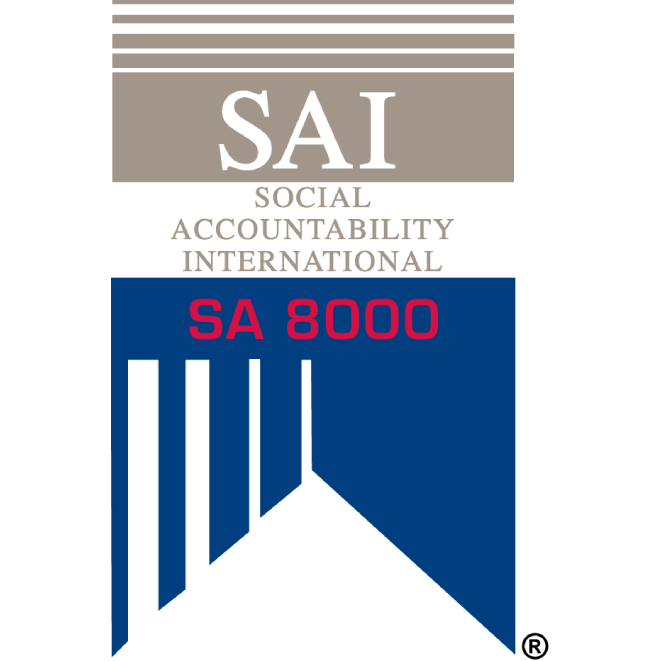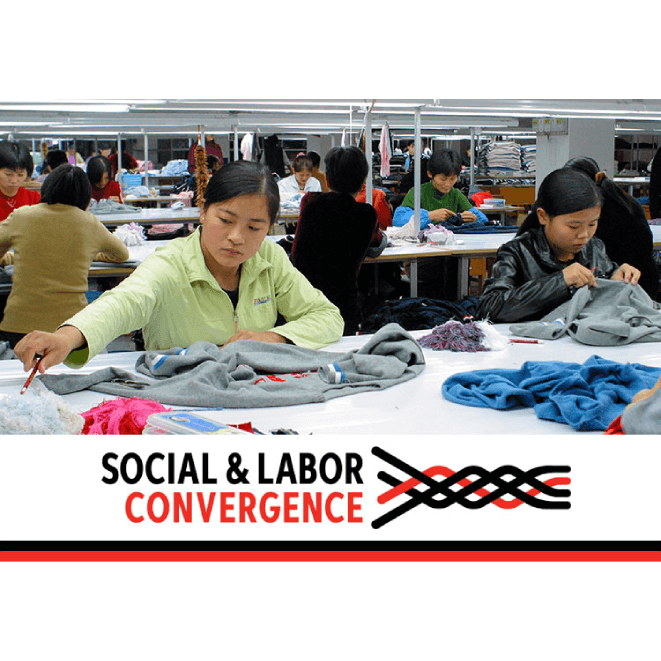
SMETA 2 Pillar & 4 Pillar
SMETA audits use the ETI Base Code, founded on the conventions of the International Labor Organization (ILO), as well as relevant local laws. SMETA audits can be conducted against 2 or 4 pillars. The two pillars mandatory for any SMETA audit are Labor Standards and Health & Safety. The two additional pillars of a 4-pillar audit are Business Ethics and Environment.
Why are businesses conducting SMETA audits?
- Achieve greater visibility into your supply chain
- Continuously improve your supplier relations
- Receive independent verification of your ethical compliance
- Strengthen your brand’s standing in ethical compliance
SMETA 2 Pillar
The SMETA 2-pillar audit the following modules:
- Labor Standards
- Health and Safety Additional Elements:
- Management Systems
- Entitlement to Work
- Subcontracting and Homeworking
- Environmental Assessment (shortened)


SMETA 4 Pillar
A SMETA 4-pillar audit covers the Labor and Health & Safety standards of the 2-pillar audit, as well as Environmental Assessment and Business Ethics.
This is the full SMETA audit and includes:
- Labor Standards
- Health and Safety
- Environmental Assessment (extended)
- Business Ethics
Benefits of SMETA for your business
- Increased visibility. Gain a greater understanding of the social and environmental performance of your business and suppliers.
- Prioritise high risks
- Improve supplier performance.
- Efficient supplier auditing
- Comply with legislation.
Amfori BSCI (Business Social Compliance Initiatives)
Amfori BSCI provides a Code of Conduct with a set of values and principles that help amfori members improve their own policies and practices, such as updating purchasing contracts to conduct business responsibly. These principles apply to all sectors worldwide and comply with international regulations (e.g., International Labour Organization, Organisation for Economic Co-operation and Development, United Nations Guiding Principles on Business and Human Rights).
The 13 social performance areas we measures
- Social management System and Cascade Effect Workers involvement and Protection
- Workers involvement and Protection
- The Rights of Freedom of Association and Collective Bargaining
- No Discrimination, Violence or Harassment
- Fair Remuneration
- Decent Working Hours
- Occupational Health and Safety
- No Child Labour
- Special Protection for Young Workers
- No Precarious Employment
- No Bonded, Forced Labour or Human Trafficking
- Protection of the Environment
- Ethical Business Behaviour
Key benefits of amfori BSCI
- High credibility of our service, helping companies since 2003
- Easy identification and prioritisation of key risk areas Alignment with internationally recognised and common principles
- Alignment with internationally recognised and common principles
- Continuous updates of our system so it remains fit for the future
- Efficient monitoring and reporting thanks to a visual dashboard
- Duplication of effort can be avoided


SA 8000 – Social Accountability
The SA8000 Standard is an auditable certification standard that encourages organizations to develop, maintain, and apply socially acceptable practices in the workplace. It was developed in 1989 by Social Accountability International, formerly the Council on Economic Priorities, by an advisory board consisting of trade unions, NGOs, civil society organizations and companies.
Elements of the SA8000
- Child Labor
- Forced or Compulsory Labor
- Health and Safety
- Freedom of Association and Right to Collective Bargaining
- Discrimination
- Disciplinary Practices
- Working Hours
- Remuneration
- Management System
What are the benefits
- Documentation of fair working practices.
- Documentation of continual improvement of your management system.
- Permanent improvement of your risk management system.
- Improved global competitiveness.
- Achieve best practice in ethical employment, trading and operations
- Introduce greater transparency to the way you run your business
- Maintain existing business and attract new customers and investors
- Gain recognition as an socially accountable organization
WCA- (Workplace Condition Assessment)
Workplace Conditions Assessment (WCA) program provides a powerful, web based solution for companies and facilities seeking to improve workplace conditions efficiently and in accordance with widely accepted industry standards and best practices.
Workplace Conditions Assessment (WCA) is an industry-agnostic and widely accepted risk-based solution in our Supply Chain Assurance suite of services. It provides an on the ground support and expertise to help companies manage Supply Chain Due Diligence specific to social and labour conditions, health & safety, environment, and business practices.
Benefits to workplace conditions for your organisation:
- Improve work conditions for a more content, healthier and productive workforce.
- Better decision making support based on real time data and knowledge management
- Good corporate governance and preferred supplier status for implementing a program that is in full accordance with industry based practices.
- Improve confidence in partnership with suppliers through greater transparency and trust
Audit Methodology Programme Consists of Five Modules Covering:
- Labour (Child/Forced Labour, Discrimination, Discipline, Harassment, Freedom of Association, Contracts);
- Wages and Hours (Wages and Benefits; Working Hours);
- Health and Safety (Work Facility, Emergency Preparedness, Occupational Injury, Machine Safety, Safety Hazards, Chemical and Hazardous Material, Dormitory, Canteen);
- Management Systems (Documentation, Records, Participation, Audits and Corrective Action Process)
- Environment (Legal Compliance, Management Systems, Waste and Air Emissions);
- Supply chain visibility and transparency beyond tier 1 and 2 with tools to identify high risk suppliers and focus your resources effectively where it matters;
- Community based sharing model to reduce audit duplication and support in Mutual Recognition Acceptance.


WRAP- (Worldwide Responsible Accredited Production)
WRAP’s Pre-Audit Self-Assessment is a tool designed for facility’s management to assess their current social compliance standing.
There are 12 key criteria by which we assess facilities. These principles guide determinations of our specific audit standards and subsequent assessments of compliance.
- Compliance with Laws and Workplace Regulations – Facilities will comply with laws and regulations in all locations where they conduct business.)
- Prohibition of Forced Labor – Facilities will not use involuntary, forced, or trafficked labor.)
- Prohibition of Child Labor – Facilities will not hire any employee under the age of 15 (14 in less-developed countries) or under the minimum age established by law for employment, whichever is greater, or any employee whose employment would interfere with compulsory schooling.
- Prohibition of Harassment and Abuse – Facilities will provide a work environment free of supervisory or co-worker harassment and abuse, and free of corporal punishment in any form.
- Compensation and Benefits – Facilities will pay at least the minimum total compensation required by local law, including all mandated wages, allowances, and benefits.
- Hours of Work – Hours worked each day, and days worked each week and each month, should not exceed the limitations of the country’s law. Facilities will provide at least one day off in every seven-day period, except as required to meet urgent business needs.
- Prohibition of Discrimination – Facilities will employ, pay, promote, and terminate workers on the basis of their ability to do the job, rather than on the basis of personal characteristics or beliefs.
- Health and Safety – Facilities will provide a safe and healthy work environment. Where residential housing is provided for workers, either directly by facilities or through labor brokers, facilities will ensure it is safe and healthy housing.
- Freedom of Association and Collective Bargaining – Facilities will recognize and respect the right of employees to exercise their lawful rights of free association and collective bargaining.
- Environment – Facilities will comply with environmental rules, regulations, and standards applicable to their operations, and will observe environmentally conscious practices in all locations where they operate.
- Customs Compliance – Facilities will comply with applicable customs laws, and in particular will establish and maintain programs to comply with customs laws regarding illegal trans-shipment of finished products.
- Security – Facilities will maintain appropriate procedures in order to ensure proper corporate security, transportation security, and people and physical security at the facility.
SLCP- Social & Labour Convergence Program
The Social & Labour Convergence Program is a new initiative designed to simplify the auditing of labour standards in apparel and footwear facilities by using a Converged Assessment Framework (CAF). Before the SLCP was introduced, facilities in the industry had to submit themselves to a wide range of audits by different organisations and standards. The SLCP aims to simplify and streamline this process.
The major benefit of the SLCP is that companies who have been verified do not need to be assessed multiple times by different bodies. Instead, they can spend their time and resources on improving labour conditions. At the same time, social and labour data becomes more comparable, making it easier to formulate and execute improvement programs. The social and labour convergence program is a multi-stakeholder program.
Conforming to the Social and Labour Convergence Program involves a three-stage process:
Data Collection => Data Verification => Data Hosting & Sharing
What are the benefits of SLCP?
The main benefit of an SLCP audit is that companies that have been verified are not required to be assessed multiple times by different bodies.
This allows them to:
- Reassign time and resources towards improving labour conditions within facilities, making informed decisions using the comparable data they now have access to.
- Avoid duplication of work and improve transparency
- Implement corrective measures that result in real change.
